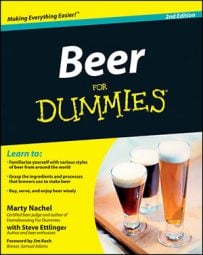Buying the ingredients for your first batch of beer is easy, almost a no-brainer. You go into a homebrew-supply shop or fill out an online order form and buy an extract kit (a can or bag of malt extract), hops, a packet of yeast, corn sugar (dextrose — 2/3 cup minimum), and enough caps (crowns) for 50 to 60 bottles. Done. That’s it! (Don’t worry about a recipe, all kit beers come with recipes included.)
Homebrewing extract kit (malt extract and yeast)
The beer you’re about to make is kit beer — no grains, no muss, no fuss. A kit brew comes complete with its own packet of dried yeast and is sold by beer style. When making beer from a kit, your only decision is what style of beer you want to make. Liquid malt extract (syrup) comes in a variety of colors and flavors, clearly labeled according to the style of beer that it’s meant to produce.
Here are some things to keep in mind when buying your kit:
For the sake of reality and authenticity, stick with an ale kit. Quality lager beers are impossible to make at the beginner level.
Just for laughs, read the directions included with the kit. If these directions call for large additions of white (cane) sugar (much like Prohibition-era homebrew), then ignore them.
Hops in beer making
Hops are available in many different varieties; they’re chosen according to the beer style the kit is designed to brew. Hops are typically packaged in 1-ounce increments and, depending on the beer style, your kit may include a few different varieties of hops.
Yeast in your beer kit
Yeast is also available in a number of different types; they’re also chosen according to the beer style the kit is designed to brew. Yeast found in beer kits is dry and packaged in small packets. Be aware that liquid yeast products are also available, but they’re not typically found in kits because liquid yeast products needs to be kept refrigerated.
Sugar in the homemade beer mix
At bottling time, you need a type of sugar called dextrose, or corn sugar. This highly refined sugar is used to prime the beer just before it’s bottled. Priming is the procedure in which a measured amount of corn sugar is mixed with the already fermented beer in order to create carbonation in the bottle. Dextrose is inexpensive and can be purchased in any volume, although many homebrew suppliers sell it in prepackaged amounts. For one 5-gallon batch, you need 3/4 cup of corn sugar for priming — no more.
Water for beer making
Water is the ingredient that makes up the bulk of your homebrew, but it’s too often taken for granted. Use bottled water over tap water. Tap water can present various problems, including the following:
If the water you’re using for brewing is from an underground well, chances are that it’s high in iron and other tastable minerals.
If your water is softened, it’s probably high in sodium.
If your water is supplied by a public works department, it may have a high chlorine content. Chlorine is volatile and can easily be boiled off, but you’d have to boil all 5 gallons — a daunting task. Chlorine can also be filtered out, or if left sitting out in an open container for about 24 hours, the chlorine will eventually degas itself from the water.
Crowns to top off your batch of beer
Bottle crowns are sometimes sold by the batch (60 crowns, which is enough for 54 bottles, with a few extras) but more typically by the gross (144 crowns). Although bottle crowns may seem to be equipment rather than ingredients, they’re consumable objects because you can use them only one time.

